What’s Up?
I hope that I am doing well somewhere in Namibia. If all goes well and I stay out of trouble, I will be back in the office late on the afternoon of Friday, April 29.
Don’t Look Now!
Today’s blog post marks 166 days in a row with a new educational blog post… As always-–and folks have been doing a really great job recently–-please remember to use our B&H links for your major gear purchases. For best results use one of our many product-specific links; after clicking on one of those you can continue shopping with all subsequent purchases invisibly tracked to BAA. Your doing so is always greatly appreciated. Please remember: web orders only. Please remember that if you are shopping for items that we carry in the BAA Online Store (as noted in red at the close of this post below) we would appreciate your business.
|
This image was created on an IPT at Nickerson Beach with the Canon EF 600mm f/4L IS II USM lens, the Canon Extender EF 2X III, and the amazing Canon EOS 7D Mark II. ISO 800. Evaluative metering +2/3 stop: 1/250 sec. at f/9. Center AF point(by necessity)/AI Servo Expand/Rear Focus AF on the skimmer’s eye and re-compose. Click here to see the latest version of the Rear Focus Tutorial. Click on the image to see a larger version. Black Skimmer resting just before sunset |
Too Many Lessons to List…
Warning
On a BIRDS AS ART IPT, we will get you out to the beach early and keep you out there till all hours. In the mornings we arrive in the pre-dawn to create images of the large flocks of skimmers blasting off. This image was created just before sunset. Right after we worked this bird we turned around to do sunset silhouettes. And then headed down to the beach for the late skimmer blast-offs!
Image Question
Why is there blue sand in the lower background?
Vertical Front End Compositions
I often go to vertical front-end compositions when am too close to the bird or at too long a focal length to fit the whole bird in a horizontal frame. Here, adapted from what I wrote in the original The Art of Bird Photography, is my take on vertical font-end compositions:
Sometimes when you are close to a fairly large bird that is roughly parallel to the back of the camera, you may wish to go vertical to show the fine details in a bird’s plumage–even though that means you will be cutting off part of the rear half of the bird. Most times you will be able to create what I call a vertical font-end composition. To do this, place the bird’s eye on, or slightly forward of, the vertical centerline, one quarter to one third of the way down in the frame; then adjust your side to side framing making sure that you leave some room in front of the bird and some room behind the bird’s legs.
Even though the original The Art of Bird Photography is totally film-based, there is a ton of important basic stuff to learn. It feels good to know that many of today’s finest bird photographers learned from one of the 42,000+ copies of this book sold to date. Heck, it put me on the map. 🙂 You can learn a ton more on the subject in the section on Advanced Composition and Image Design in The Art of Bird Photography II (ABP II: 916 pages, 900+ images, all digital, and only on CD). Best deal? Purchase the two-book combo and save $10 on the pair. I can only wish that the information in these two books had been available back in 1983…
The image after rotation |
Image Rotation
My workflow is all about Keyboard Shortcuts. Why? Approaching age 70 my time is more valuable everyday and I simply have never wanted to waste time going through drop-down menus and right-clicking. Here I use R for the Ruler Tool (my personalized shortcut)to draw the line that I want leveled and then Command + forward slash (another of my personalized shortcuts) to bring up the Image Rotation > Arbitrary window instantly. You can learn all of my Keyboard Shortcuts and tons more including dozens of Photoshop tips in my Digital Basics File
The image after cropping |
John Heado Add Canvas via Content Aware Fill
Once I get to this point I use the Magic Wand Tool (my M–I use W for the Quick Selection Tool so that I can toggle between the two instantly) to select the four skinny triangles. Make sure that the Contiguous box is unchecked. Then go Select > Modify > Expand and expand the selection by from 3-8 pixels. Then go Edit > Fill > Content Aware and hit OK. Watch the magic. Inspect your work by working large and cleaning up any anomalies. Most of the time when you are working with relatively clean backgrounds and foregrounds (as here) the results will be perfect right out of the box.
|
From upper left clockwise to center: Black Skimmer head portrait, American Oystercatcher dining on surf clam flesh, Common Tern at sunset, Common Tern adult swallowing flatfish, Black Skimmer in flight, newborn Common Tern chick, American Oystercatcher with chick, fresh juvenile Common Tern (with fill flash), and Common Terns copulating. |
Nickerson Beach Terns/Skimmers/Oystercatchers Instructional Photo-Tour (IPT): July 18-22, 2016. 4 1/2 DAYS: $1899
Meet and greet at 3pm on the afternoon of Monday, July 18. Limit 10.
The primary subject species of this IPT will be the nesting Common Terns. The trip is timed so that we will get to photograph tiny chicks as well as fledglings. There will be lots of flight photography including adults flying with baitfish. Creating great images of the chicks being fed is a huge challenge. In addition to the terns we will get to photograph lots of Black Skimmers courting, setting up their nesting territories, and in flight (both singles and large pre-dawn flocks blasting off). Midair battles are guaranteed on sunny afternoons. And with luck, we might even see a few tiny chicks toward the end of the trip. We will also get to photograph the life cycle of American Oystercatcher. This will likely include nests with eggs and tiny chicks, young being fed, and possibly a few fledglings.
Nesting Piping Plover is also possibly. There will be lots of gulls to photograph; most years I am able to find a few Lesser Black-backed Gulls of varying ages in addition to the Herring, Ring-billed, and Great Black-backed Gulls. You will learn to identify and age the various gull species. There will likely be some Willets feeding along the surf and with luck we might get to photograph a handsome juvenile or two. In addition to the locally breeding shorebirds, we will likely get to see some southbound migrant arctic-and sub-arctic breeding shorebird species such as Sanderling, Semipalmated Plover, and maybe even Red Knot.
|
From upper left clockwise to center: Black Skimmers with tiny chick, Common Tern landing with baitfish for young, fledged Common Tern chick in dunes, American Oystercatchers/display flight, adult Common Tern with pipefish for chick, Common Tern fledgling in soft light, American Oystercatcher on nest with eggs, American Oystercatcher 3-egg clutch, battling Black Skimmers. |
The IPT Logistics
The tour will begin with a meet and greet on the afternoon of Monday, July 18, 2016. That will be followed by our first shooting session at the beach. From Tuesday through and including all of Friday we will have two photography sessions daily. Our morning sessions will start very early so that we are on the beach well before sunrise. We usually photograph for about four hours. Then we will enjoy a group brunch. We will always have a midday break that will include a nap for me. That followed by our daily afternoon classroom sessions that will include image review, workflow and Photoshop, and a review/critique of five of your trip images. Folks are always invited to bring their laptops to brunch for image sharing. I always have mine with me but heck, I am a big show-off. Afternoon in-the-field sessions generally run from 5pm through sunset.
Breakfasts are grab what you can. Four brunches are included. Dinners (if at all) will be on your own as we will often get back to the hotel at about 9pm. There is a fridge in every room and a supermarket within walking distance of the hotel so nobody should starve. You will learn a ton during the nine shooting sessions, the four in-classroom sessions, and even at lunch. Early morning and late afternoon parking is free. If we want to head back to the beach early we will need to arrange tight carpools and share the $30/vehicle parking fee. Non-photographer spouses, friends, or companions are welcome for $100/day, $450 for the whole IPT.
Save a space by calling Jim or Jen at the office at 863-692-0906 and arranging to leave your deposit of $599–credit cards are accepted for deposits only. Your balance will be due on April 18, 2016. I hope that you can join me for what will be an exciting and educational IPT.
Please Remember to use our Affiliate Links 🙂
To show your appreciation for my continuing efforts here, we ask, as always, that you get in the habit of using my B&H affiliate links on the right side of the blog for all of your photo and electronics purchases. Please check the availability of all photographic accessories in the BIRDS AS ART Online Store, especially the Mongoose M3.6 tripod heads, Gitzo tripods, Wimberley heads and plates, LensCoats and accessories, and the like. We sell only what I have used, have tested, and can depend on. We will not sell you junk. We know what you need to make creating great images easy and fun. And we are always glad to answer your gear questions via e-mail. I just learned that my account was suspended during my absence; it should be up and running by Monday at the latest.
I would of course appreciate your using our B&H affiliate links for all of your major gear, video, and electronic purchases. For the photographic stuff mentioned in the paragraph above we, meaning BAA, would of course greatly appreciate your business. Here is a huge thank you to the many who have been using our links on a regular basis and visiting the BAA Online store as well.
Be sure to like and follow BAA on Facebook by clicking on the logo link upper right. Tanks a stack!
Typos
In all blog posts and Bulletins, feel free to e-mail or to leave a comment regarding any typos or errors. Just be right 🙂

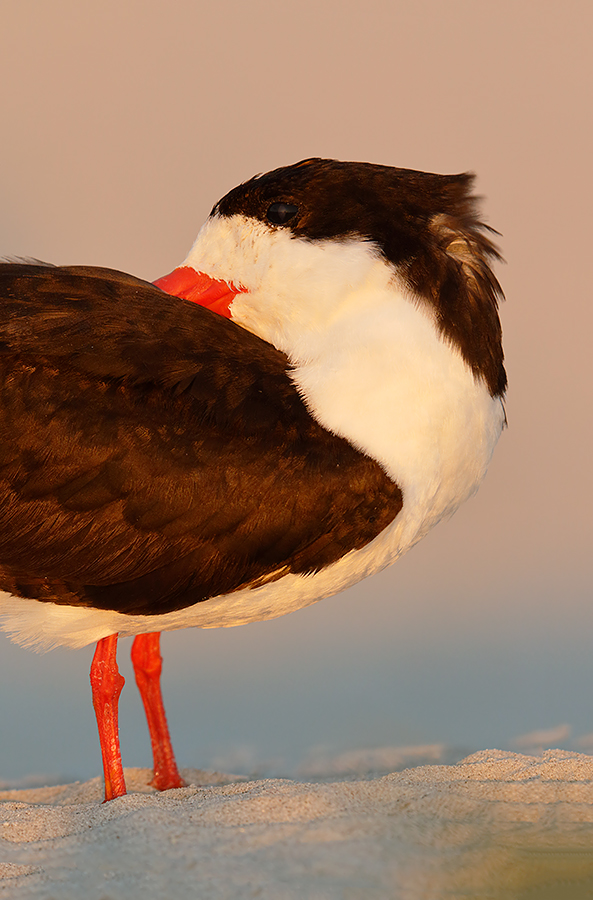
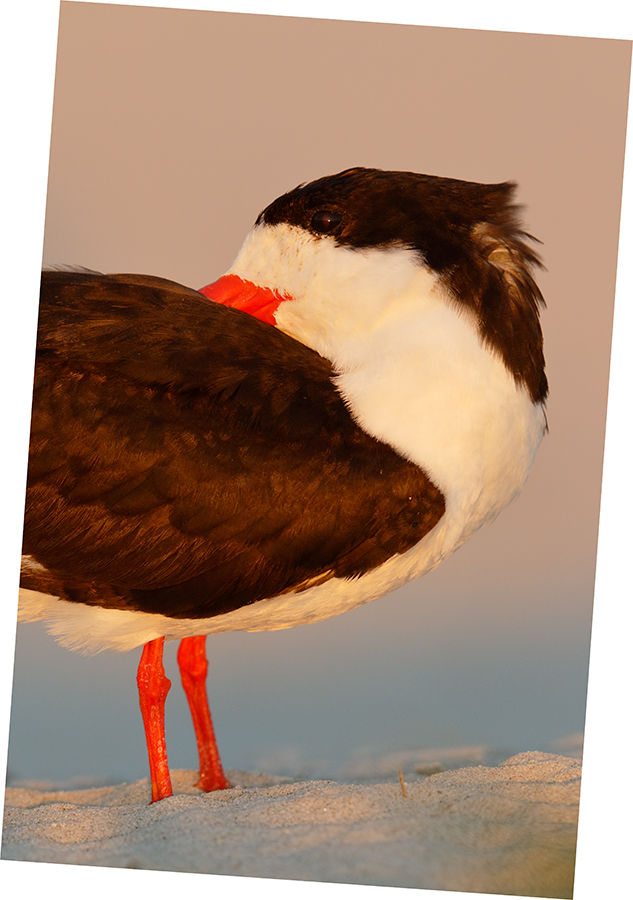
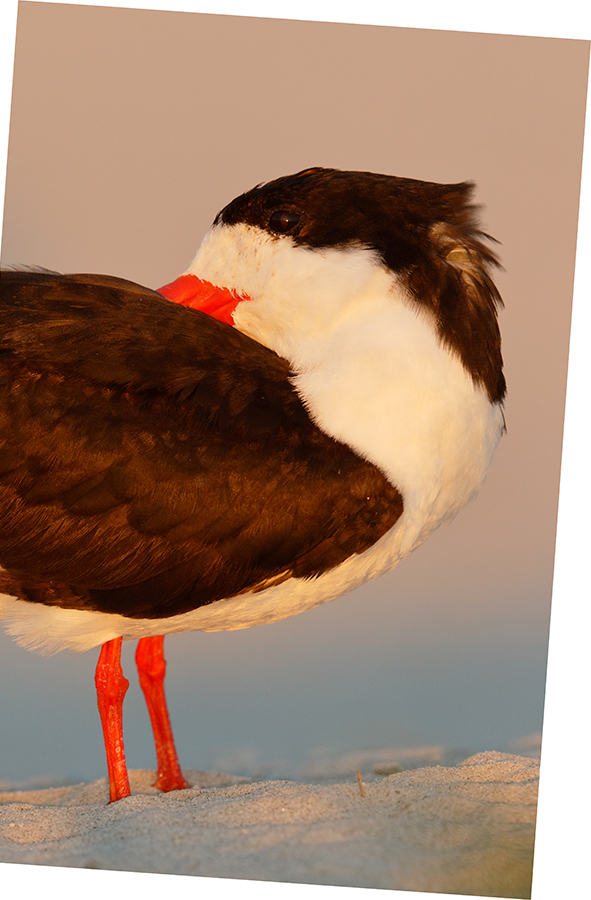
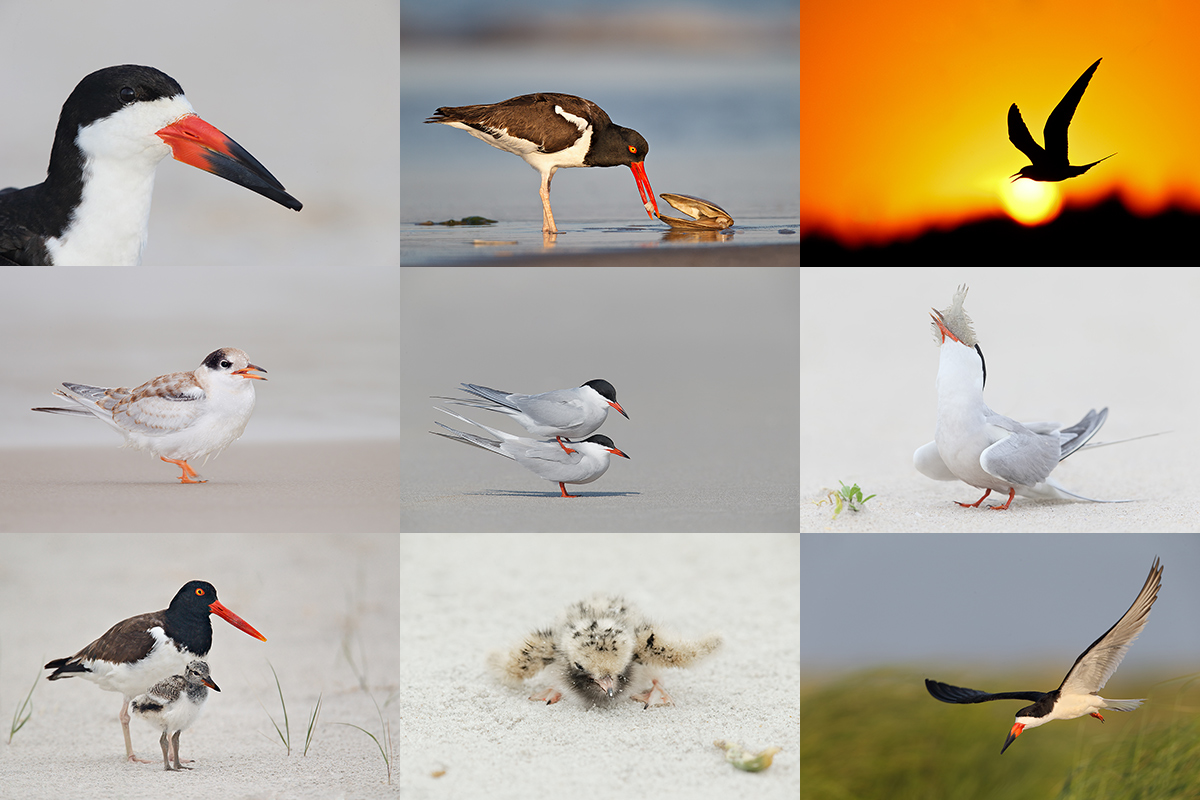
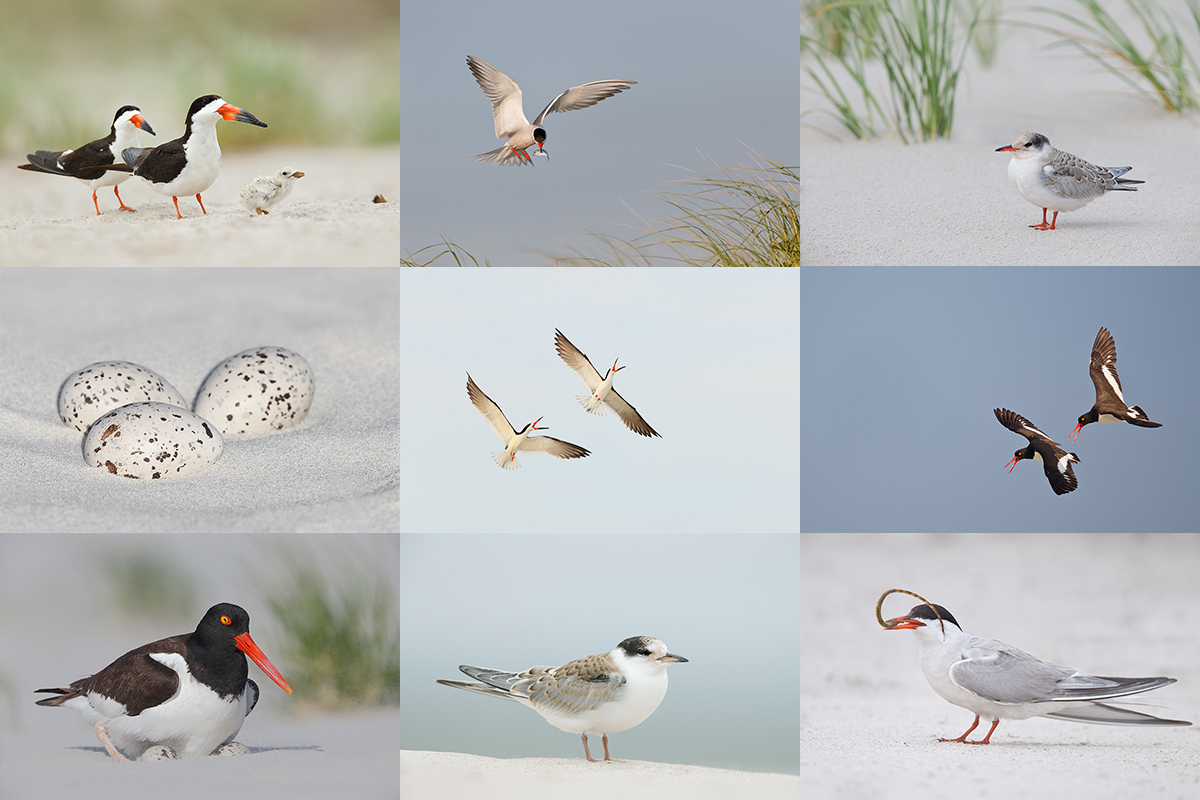













I suspect the blue sand is because its shadowed and the white balance is set for the beautiful warm light.
Andy
Why blue sand, indeed? Based on where the sun sets at Nickerson, that gentle slope down to the water, and the horizon line, I’d say it’s not sand at all. That’s the Atlantic Ocean with blurred waves. The Skimmers and Terns both enjoyed that area when people weren’t walking through it. Great for blast offs, too!
To pull it off, you were tripod mounted, probably in a sitting position, to keep the bird framed like you were directly in visual line with it, but have enough down angle to get that water in the shot.
By the way, I picked up the 16-35 f/4 L from B&H, with my starting point being your banner at the top of page. Do let me know if you don’t get some credit for the purchase and I’ll pass along any order details to make sure you do.
And just to clarify, you said lower background, not foreground where there is also some blues and greens, so I responded accordingly.
Is the blue sand in shadow from the mound the bird is standing on?
Beautiful light on a beautiful bird portrait !
That fine image brings back wonderful memories of a great trip. The photograph was taken right at sunrise and I’d guess the blue sand was in soneone’s or something’s shadow, maybe yours.
I am happy this morning because I got some good photos of lesser double-collared sunbirds at Kirstenbosch this morning. For those who don’t know them, look up these gorgeous hummingbird-like birds.